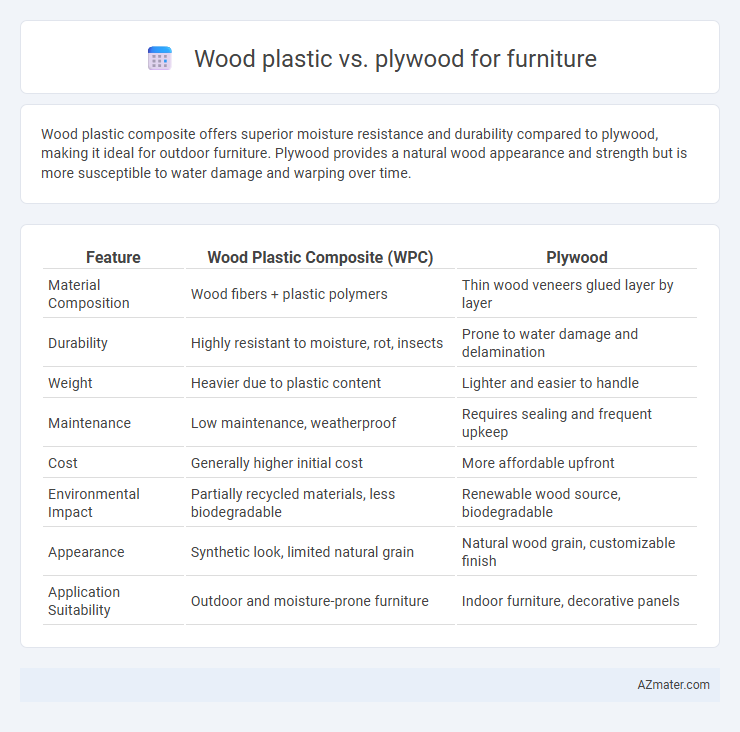Wood plastic composite offers superior moisture resistance and durability compared to plywood, making it ideal for outdoor furniture. Plywood provides a natural wood appearance and strength but is more susceptible to water damage and warping over time.
Table of Comparison
| Feature | Wood Plastic Composite (WPC) | Plywood |
|---|---|---|
| Material Composition | Wood fibers + plastic polymers | Thin wood veneers glued layer by layer |
| Durability | Highly resistant to moisture, rot, insects | Prone to water damage and delamination |
| Weight | Heavier due to plastic content | Lighter and easier to handle |
| Maintenance | Low maintenance, weatherproof | Requires sealing and frequent upkeep |
| Cost | Generally higher initial cost | More affordable upfront |
| Environmental Impact | Partially recycled materials, less biodegradable | Renewable wood source, biodegradable |
| Appearance | Synthetic look, limited natural grain | Natural wood grain, customizable finish |
| Application Suitability | Outdoor and moisture-prone furniture | Indoor furniture, decorative panels |
Introduction: Comparing Wood Plastic and Plywood for Furniture
Wood plastic composites (WPC) offer enhanced durability, moisture resistance, and low maintenance compared to traditional plywood, making them ideal for outdoor and high-humidity furniture applications. Plywood remains favored for its natural wood appearance, ease of customization, and cost-effectiveness, especially in indoor furniture projects. Evaluating factors like longevity, environmental exposure, and aesthetic preference is crucial when selecting between wood plastic and plywood for furniture construction.
Material Composition: What Sets Wood Plastic and Plywood Apart?
Wood plastic composite (WPC) consists of a blend of wood fibers and thermoplastic polymers, providing enhanced moisture resistance and durability compared to traditional plywood, which is made from thin layers of wood veneer glued together with adhesives. The polymer matrix in WPC offers superior resistance to rot, insects, and warping, making it ideal for outdoor furniture, while plywood's natural wood layers provide a classic aesthetic but require protective finishes to prevent water damage. This fundamental difference in material composition influences their performance, maintenance needs, and suitability for various furniture applications.
Durability and Strength: Which Material Lasts Longer?
Wood plastic composites (WPC) offer superior durability and resistance to moisture, rot, and insects compared to plywood, making them ideal for long-lasting furniture in humid environments. Plywood, while strong and capable of bearing significant weight, is prone to delamination and warping over time when exposed to water or extreme conditions. For furniture requiring maximum longevity and minimal maintenance, wood plastic composites generally outperform plywood in strength retention and weather resistance.
Moisture and Weather Resistance: Performance in Different Environments
Wood plastic composites (WPC) offer superior moisture and weather resistance compared to plywood, making them ideal for outdoor furniture exposed to rain and humidity. Plywood tends to absorb water, leading to swelling, warping, and potential fungal growth if not properly sealed. WPC's resistance to moisture and UV degradation ensures durability and minimal maintenance in varying environmental conditions.
Maintenance Requirements: Ease of Care and Cleaning
Wood plastic composite furniture requires minimal maintenance, as it resists moisture, pests, and stains better than plywood, reducing the need for frequent cleaning or protective treatments. Plywood furniture demands regular sealing or varnishing to prevent water damage and surface wear, and it may require more careful cleaning to avoid delamination or warping. Easy wipe-downs with mild soap and water suffice for wood plastic composites, whereas plywood often needs specialized cleaners to maintain its finish and longevity.
Environmental Impact: Sustainability and Eco-Friendliness
Wood plastic composite (WPC) utilizes recycled plastics and wood fibers, significantly reducing landfill waste and lowering reliance on virgin timber, promoting sustainability in furniture manufacturing. Plywood production often involves high energy consumption and formaldehyde-based adhesives, which contribute to indoor air pollution and environmental concerns. Choosing WPC over plywood supports eco-friendly practices by enhancing resource efficiency and minimizing harmful emissions throughout the product lifecycle.
Aesthetic Options: Design Flexibility and Surface Finishes
Wood plastic composites offer extensive design flexibility, enabling intricate shapes and curves that are difficult to achieve with traditional plywood. Plywood provides a classic, natural wood grain appearance ideal for high-end, authentic finishes but is limited in surface texture variety compared to wood plastic's ability to mimic diverse materials. Surface finishes on wood plastic are more durable and weather-resistant, supporting a wider range of colors and textures suited for innovative furniture designs.
Cost Comparison: Initial Investment and Long-Term Value
Wood plastic composite (WPC) furniture typically requires a higher initial investment compared to plywood due to its durability and resistance to moisture and pests. Over the long term, WPC offers greater value by reducing maintenance costs and extending the furniture's lifespan, whereas plywood may incur frequent repairs and replacements in humid or high-traffic environments. Cost-effectiveness depends on balancing upfront expenses with longevity and upkeep in the specific use case.
Applications: Best Uses in Furniture Design
Wood plastic composite (WPC) excels in outdoor furniture applications due to its high resistance to moisture, insects, and rot, making it ideal for patio sets, garden benches, and decking furniture. Plywood is preferred for indoor furniture design, such as cabinets, shelves, and chairs, owing to its strength, smooth surface, and ease of finishing with veneers or paint. Selecting WPC or plywood depends on environmental exposure and aesthetic needs, with WPC suited for durability in harsh outdoor conditions and plywood favored for versatile indoor craftsmanship.
Conclusion: Choosing the Right Material for Your Furniture
Wood plastic composites offer superior moisture resistance and durability, making them ideal for outdoor or high-humidity environments, whereas plywood provides greater aesthetic appeal and ease of customization for indoor furniture projects. Selecting the right material depends on the specific use case, budget constraints, and desired maintenance level, with wood plastic excelling in longevity and plywood in traditional craftsmanship. Careful consideration of these factors ensures optimal performance and satisfaction in furniture applications.

Infographic: Wood plastic vs Plywood for Furniture
 azmater.com
azmater.com